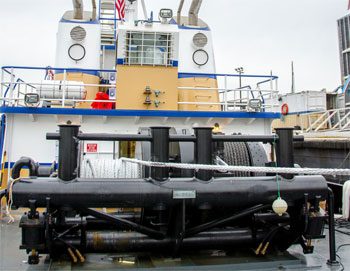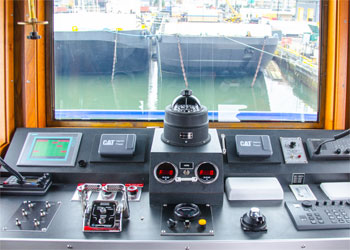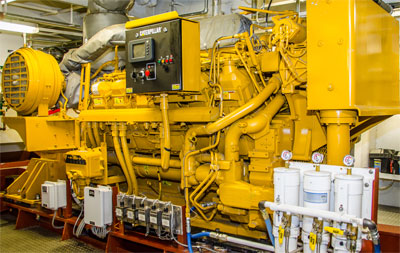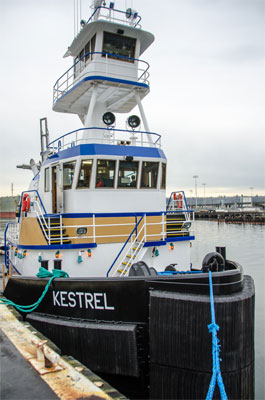Olympic Tug & Barge’s new 94-foot conventional twin-screw tugboat Kestrel went into service in Southeast Alaska in the late fall of 2012. Designed by the Louisiana firm of Entech & Associates, the boat’s mission is to deliver fuel to the settlements and camps along Alaska’s Inside Passage.
The tug is paired with PM 230, a 28,000-barrel petroleum barge owned by Petro Marine Services, based in Seward, Alaska. Together the vessels are plying the intricate waterways of Southeast Alaska to bring a variety of fuels to communities that have no road links to the outside world and are totally dependent for fuel on vessels like Kestrel and its barge (See Professional Mariner #168/May 2013).
 |
|
The tug’s Markey TESD-32 100-hp electric-drive double-drum stern winch. |
The new tug has been highly successful in its first few months of operation, according to Olympic Tug & Barge General Manager Sven Chistensen. “It’s going great, one big high point,” he said.
While operating smoothly, the boat has pleased its six-man crew. “The guys like the amenities on board,” and “the captain is happy about everything,” Christensen said.
The tug has a beam of 32 feet and draws 11.5 feet of water. It is powered by a pair of Caterpillar 3512C Tier 2 engines providing a total output of 3,000 hp, turning 87-inch stainless steel propellers through Twin Disc MGX-5600 gears with a ratio of 6.04:1.
On the stern, the boat has a Markey TESD-32 100-hp electric-drive double-drum towing winch with 2,600 feet of two-inch wire.
 |
Markey Machinery first applied its variable-frequency-drive technology to bow winches on ship assist and escort tugs, according to Scott Kreis, vice president of sales with the Seattle-based manufacturer of winches. Having proved its capability there, this type of electric winch is increasingly appearing on tugs like Kestrel that use stern winches for towing barges.
They offer several advantages, according to Kreis. The performance range of an electric winch with a variable frequency drive unit is much broader than a hydraulic winch of comparable horsepower, he said.
There are also economic incentives. “Installing an electric winch is far less expensive than the installation of a hydraulic winch,” he said. That’s because of the higher cost of running the hydraulic lines from the winch to their power sources, compared with electrical lines.
And for crew comfort. “The electric winches are much less noisy,” he said.
And there are environmental considerations as well. Hydraulic fluid can leak and spill. Electric winches eliminate that risk.
Frank Basile, the man behind the design of Kestrel, describes himself as “president, owner and dishwasher” of the marine design firm of Entech & Associates, which is based in Houma, La.
 |
|
The view from the raised pilothouse. Olympic asked the designer to add 12 inches to the height over previous boats of similar design. |
Outwardly, Kestrel looks very similar to the 94-foot tugs Entech designed for Vane Brothers (See ATR 2011). Vane Brothers, which is based in Baltimore, has built six of the 94-foot, 3,000-hp vessels for bunkering and fuel deliveries in the rivers and bays of the Mid-Atlantic region.
“The hull design is identical,” Basile said of the Vane boats and Kestrel. But inside the hull, it is a different story.
At the owner’s request, Kestrel has been designed so that it can be converted to an ATB. “The interior structure is completely different” from the Vane boats, Basile said.
If Kestrel were to be converted to an ATB, it would have a connection system installed in the bow to allow it to push a barge from its stern notch. The point where the barge and the tug link would undergo powerful stresses. So the interior structural elements of Kestrel have been beefed up to cope with “the loads up front you wouldn’t regularly get,” Basile said.
“The pins (of the connection system) take all that strain. You’d better have some structure around it,” Basile observed.
Kestrel’s double-drum stern winch is also much bigger than the ones on the Vane boats. “It’s a monster,” Basile said. “We had to make some adjustments there.” So just as in the bow, the internal elements of the stern also had to be more substantial.
While Kestrel and the Vane boats look the same below the waterline, up above there are some visible differences. “This boat has a semi-forecastle,” Basile said of Kestrel. “It’s a little better heading into the seas. It keeps the boat a little dryer.”
The pilothouse is a tad higher, with 12 inches greater height of eye for better visibility. There were also changes prompted by the fact that Alaska’s climate is much more severe than the Chesapeake region’s. So the pilothouse has been thoroughly insulated and the windows are all heated.
“They tell me the boat is great, great,” Basile said.
 |
|
One of the twin Caterpillar 3512C Tier 2 engines which together have an output of 3,000 hp. |
While the boat may be perfectly suited for its current operations and environment, a significant change is on the horizon.
The barge Kestrel is towing now in Alaska has a single-skin hull. Under the terms of the Oil Pollution Act of 1990, the barge must be retired by the end of 2014.
That is a development that Olympic Tug & Barge, a subsidiary of Seattle-based Harley Marine Services, clearly prepared for in its design of Kestrel.
“Once the barge is obsolete it will have to be replaced,” said Gregg Nelson, Harley Marine vice president and director of engineering. “The barge doesn’t belong to us. One of the options is to go to an ATB.”
When the current barge is retired, the forward-looking elements of the design could prove invaluable. “It was a lot cheaper to do it now than down the road,” Nelson said of the design that will allow Kestrel to be quickly and easily converted to the tug unit of an ATB.
While Kestrel seems to be meeting or exceeding the expectations of its operator and its crew, the boat’s full realization of its potential still lies ahead as an ATB.

